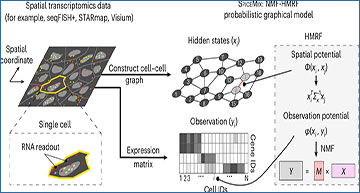Spatial transcriptomics can reveal spatially resolved gene expression of diverse cells in complex tissues. However, the development of computational methods that can use the unique properties of spatial transcriptome data to unveil cell identities remains a challenge. Researchers at Carnegie Mellon University have developed SPICEMIX, an interpretable method based on probabilistic, latent variable modeling for joint analysis of spatial information and gene expression from spatial transcriptome data. Both simulation and real data evaluations demonstrate that SPICEMIX markedly improves on the inference of cell types and their spatial patterns compared with existing approaches. By applying to spatial transcriptome data of brain regions in human and mouse acquired by seqFISH+, STARmap and Visium, the researchers show that SPICEMIX can enhance the inference of complex cell identities, reveal interpretable spatial metagenes and uncover differentiation trajectories. SPICEMIX is a generalizable analysis framework for spatial transcriptome data to investigate cell-type composition and spatial organization of cells in complex tissues.
Overview of SPICEMIX
Gene expression measurements and a neighbor graph are extracted from spatial transcriptome data and fed into the SPICEMIX framework. SPICEMIX decomposes the expression yi in cell (or spot) i into a mixture of metagenes weighted by the hidden state xi. Spatial interaction between neighboring cells (or spots) i and j is modeled by an inner product of their hidden states, weighted by Σ−1xΣx−1, the inferred spatial affinities between metagenes. The hidden mixture weights X, the metagene spatial affinity Σ−1xΣx−1, and K metagenes M, all inferred by SPICEMIX, provide unique insight into the spatially variable features that collectively constitute the identity of each cell.
Chidester B, Zhou T, Alam S, Ma J. (2023) SPICEMIX enables integrative single-cell spatial modeling of cell identity. Nat Genet [Epub ahead of print]. [abstract]





